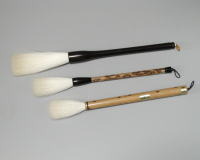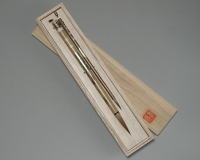

Total:131items
- Pottery & Porcelain (18)
- Lacquerware (4)
- Glasswork (2)
- Wood & Bamboo Work (19)
- Leather Work (1)
- Papermaking (13)
- Textile (20)
- Dyeing products (5)
- Masonry (1)
- Metal Work (11)
- Stationery (4)
- Livingware (3)
- Accessory (4)
- Toys & Entertainment (14)
- Interior (2)
- Other crafts (10)

 |
Main Production Site:Tokyo |
 《Characteristics》
《Characteristics》While there is a Kansai-style (West Japan) “Katame-Fude (literally, hard writing brush)”, the one in Tokyo is called “Edo-Fude” or “Sabaki-Fude”, which traces its history back to the Edo Period (17-19c). When “Sankin-Kotai(*1)” took place and many craftsmen were gathered from all over the country into Edo (Tokyo of today), their techniques and craftsmanship were introduced and completed the present Edo-Fude consequently.
“Katame-Fude” is used by dipping two-third of the brush in India ink from the tip, while “Sabaki-Fude” is used by fully dipping the brush in the ink as close as to the brush shaft.
These writing brushes have been crafted till now to supply with the most suitable brush for users, depending on their respective tastes, skills, ways of writing, sizes and style of writing(*2*3).
(*1) Sankin-Kotai:
One of the Japanese federal systems in the Edo period (17 to 19c), by which the regional leaders were obliged to visit the central government in Edo every two years. The purpose of this system was to make the regional samurais (warriors) spend a huge amount of money on the way back and forth between their domain and Edo, not only to have them guard the central government. This prevented their rebels against the Edo government due to the lack of financial power.
[There are various brushes named in accordance with its level of elasticity]
Kengo-Fude (Hard Brush)
The hardest one among all brushes.
The material is the hair of antelope in Nepal, and it is mainly used for calligraphy works. This is especially used to express strongly swept lines. However, since the Washington Convention has banned importing the hair of Nepal antelope, the genuine brush can hardly be seen these days.
Kenmo-Fude (Blended Hair Brush)
A comparatively harder brush than others. Depending on how to blend different types of hair, it can be harder or softer. The materials used for this brush are the hair of raccoon dog, deer, and horse; the major users of this brush used to be beginners, because of its flexibility and elasticity.
Nowadays, since not so many raccoon dogs are seen as before in Japan, Kenmo-Fude is not often made. Furthermore, some brushes are made for professional calligraphers who specially write in “Kaisho”(*2), by blending the hair of Japanese weasels, Siberian weasels, and the tails of horses.
(*2) Kaisho:
This is one of the styles of writing Chinese characters, also known as Shinsho or Seisho. It literally means “the genuine or true writing”. It is the most popular, basic and simplest way of writing in Japan. In this way of writing, every line and point of each character are properly shown as first taught at schools.
Junpaku-Yomo-Fude (Pure-White-Sheep-Hair Brush)
The material used is the hair of Chinese goat and the tail of white-horse. It neatly tidies the brush tip and gives proper elasticity. Its hardness depends on the combination ratio of the hair. Beginners find it easier for their practice to use the brush with more horse hair.
Today, the domestic horse hair is hard to procure, so the most brushes are made of nylon hair instead. Moreover, adding a little amount of horse hair to the fine quality wool makes a good brush, for writing in “Sosho” manner(*3).
(*3) Sosho:
A type of calligraphy writing, which writes faster by omitting the number of strokes. Different from “Gyosho”, another writing type in calligraphy, the omission in Sosho is much obvious. Since there are many rules in omission in Sosho, it is hard to write and read without learning them.
Jun-Yomo Fude (Genuine Wool Brush)
A brush made of the hair of goat in China. The goat hair is imported after being classified into more than 15 classes in accordance with the parts from which the hair is taken. Combining different classes of hair produces the difference in writing, such as the amount of ink the brush can hold, how the strokes are blurred, and the shapes of the beginning of brush-strokes.
Using this type of brush requires excellent skills since it makes a different expression with its length, thickness, and the shape of its brush tip.
[The Designated Traditional Craft of the Governor of Tokyo]
Source: Fude-Kobo Kamei
Translation by: Aya Matsui, reviewed by Hiroko Okamura

| Materials | Hair of sheep, goat, horse, and deer etc. |
|---|---|
| Crafting Processes | 1) Selection
The animal hair for the material of brushes, varies in length and quality even among the same species. The craftsmen classify the hair with their skilled sight and touch. 2) Boiling The raw hair contains some oil natural to animals, which would repel the ink from the brush; if it is left on the hair, the brush would not hold enough ink and the brush tip may split. Thus, it is required to remove the oil thoroughly out of the hair by boiling it for a long time. 3) Drying Dry the hair after boiling. 4) Matching the Length Sort the hair roughly by length if necessary. 5) Roasting Roast the hair to make the oil ooze out as well as to straighten the hair. 6) Kneading Sprinkle the hair with ashes made of burnt rice hulls, wrap them in a piece of cloth and knead it. 7) Aligning Use special tools to align the hair. 8) Removal Remove the pieces of hair which are cut in the end or curled by using a pocket knife. 9) Making the brush core Trim the hair to be the part called “Inochi-ge (life-hair)”, which is the core and the most important part of the brush. 10) Shaping Once the length of brush core is decided, combine the hair for other parts around it, such as the tip, the end (close to the shaft) and the body and make a shape of the brush. 11) Kneading Put the rough shape of brush into 5 or 6 bunches and mix them together evenly. 12) Removal Remove hair that does not fit in the bunch, while keeping it moist. 13) Making Core With a special tool “Koma”, subdivide the above bunches into the portion of one brush. Moreover, check the twisted hair that sticks out of the bunch and remove it (as it will cause the split of brush). 14) Covering Cover the brush with a thin sheet of hair to look neat. 15) Binding Tie the brush with hemp thread, iron it, and pull the thread tightly while the hair is still hot. 16) Sticking Glue the brush to the shaft. 17) Finishing To keep the shape during the storage and to somewhat straighten the brush, soak the brush in the glue, and squeeze extra glue out with a thread to finish. |
| History | The history of the writing brush is referred to “Nihon-Shoki (the oldest chronicles of Japan)” which describes that Monk Doncho from Koguryo in the Korean Peninsula brought papermaking and brush making techniques for calligraphy at the time of Emperor Suiko in Asuka period (6-8c). It is said that this is how brush, black ink and inkstone were first introduced into Japan.
Alternatively, it is said that Kukai (or Kobo-Daishi, a famous monk and calligrapher) introduced brush making techniques into Japan. The brush making technique originally started from Kyoto and Nara in Japan, which were once the capital cities, then developed around Toyohashi in Aichi Pref. and Kumano in Hiroshima Pref., by adopting the Japanese calligraphy and environment. In comparison to the brushes produced in the above-mentioned places, the history of Edo-Fude is shorter as it was started in the Edo period (17-19c). When the center of economy and politics was shifted to Edo (present Tokyo), warriors and merchants all around the country migrated there. Literacy and arithmetic are always crucial to merchants. In the middle age of Edo period, the number of “Terakoya (private schools)”, where reading, writing and arithmetic are taught to children, increased drastically; accordingly, the demand for writing brushes used at those schools rose in parallel. The skilled craftsmen came to Edo from all over the country and began to make writing brushes which are original and suitable for Edo, which led to the making of Edo-Fude. After the World War II, the rebirth of Japan advanced, and went into the rapid economic growth period. In the society which makes much of mechanization, mass production, and quick transportation, the culture of Edo-Fude seemed to noticeably decline; still, it survived the period, supported by the royal users. Then, unique Edo-fude started to be produced to meet the needs of professional calligraphers. As the domestic economy becomes stable, people tend to seek to be fulfilled in their pastime and hobby. The more adult education centers for calligraphy were opened, the more people were eager to improve their writing skills to write better and more beautifully. Ever since the Edo period, Edo-Fude has accepted a variety of writing styles and refined the techniques to respond to the users’ changing needs. As a result, various shapes, materials, and sizes of Edo-Fude are produced today. |
| Related URL | http://www.edofude.co.jp/ |
◆Exhibition / Showcase
Assistance needed? For inquiries in English:
JTCO Contact Form
Your inquiries will be forwarded by JTCO in Japanese to the organization you wish to contact.



